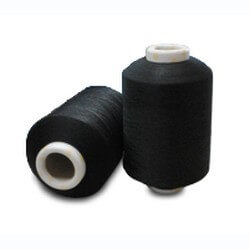Covered elastic yarn has emerged as a game-changer in the textile industry, offering a perfect blend of stretch, durability, and versatility. This innovative material has found its way into countless applications, from high-performance sportswear to comfortable everyday clothing. In this comprehensive guide, we’ll explore the world of covered elastic yarn, delving into its properties, production methods, and diverse uses across various sectors.
Unveiling the Secrets of Covered Elastic Yarn

Covered elastic yarn is a remarkable textile innovation that combines the elasticity of rubber or spandex with the strength and aesthetic appeal of conventional yarns. This unique combination results in a material that offers superior stretch and recovery properties while maintaining a soft, comfortable feel against the skin.
The core of covered elastic yarn typically consists of elastane or rubber, which is then wrapped or covered with natural or synthetic fibers such as cotton, polyester, or nylon. This covering process not only enhances the yarn’s appearance but also improves its durability and resistance to abrasion.
The Science Behind Elasticity
The elasticity of covered elastic yarn stems from its core material, which is designed to stretch and return to its original shape. This property is crucial for creating garments that conform to the body’s movements and maintain their shape over time.
When stress is applied to covered elastic yarn, the elastic core elongates while the covering fibers redistribute around it. Upon release of the stress, the core contracts, bringing the covering fibers back to their original position. This dynamic interplay between the core and covering is what gives covered elastic yarn its unique characteristics.
Production Techniques and Innovations
The production of covered elastic yarn involves sophisticated machinery and precise control over various parameters. The covering process can be accomplished through different methods, including:
- Single covering: A single layer of fiber is wrapped around the elastic core.
- Double covering: Two layers of fibers are wrapped around the core in opposite directions, providing enhanced stability and uniformity.
- Air covering: Fibers are entangled around the core using high-pressure air, resulting in a softer, more voluminous yarn.
Recent advancements in production technology have led to the development of multi-component covered elastic yarns, which incorporate additional functional fibers or materials to enhance specific properties such as moisture-wicking or antimicrobial capabilities.
Material Selection and Its Impact
The choice of covering material significantly influences the final properties of covered elastic yarn. Natural fibers like cotton offer breathability and comfort, while synthetic fibers such as polyester provide durability and quick-drying characteristics.
Manufacturers often experiment with blends of different fibers to achieve optimal performance for specific applications. For instance, a combination of nylon and spandex might be used for swimwear, offering excellent chlorine resistance and shape retention.
Applications Across Industries: From Fashion to Function
Covered elastic yarn has found its way into numerous industries, revolutionizing product design and performance across various sectors. Its versatility and unique properties make it an invaluable material for a wide range of applications.
Fashion and Apparel: Comfort Meets Style
In the fashion industry, covered elastic yarn has become a staple for creating form-fitting, comfortable garments. Its ability to stretch and recover allows for designs that hug the body without restricting movement, making it ideal for:
- Activewear and athleisure clothing
- Lingerie and undergarments
- Denim and stretch pants
- Swimwear and beachwear
Designers appreciate the freedom covered elastic yarn provides, allowing them to create garments that combine style with functionality. The material’s ability to maintain shape even after repeated wear and washing cycles has made it a favorite among consumers who value both comfort and durability in their clothing.
Medical and Healthcare: Supporting Wellness
The medical field has embraced covered elastic yarn for its unique properties, particularly in the development of compression garments and supportive wear. Some key applications include:
- Compression stockings for improving circulation
- Orthopedic supports and braces
- Post-surgical garments for recovery and healing
- Medical-grade bandages and wraps
The controlled stretch and recovery of covered elastic yarn allow for the creation of medical devices that provide consistent pressure and support, aiding in the management of various conditions and promoting faster recovery times.
Industrial and Technical Textiles: Engineering Solutions
Beyond consumer goods, covered elastic yarn has found its place in industrial and technical applications, where its properties are leveraged to solve complex engineering challenges. Some notable uses include:
- Automotive interiors and seating
- Aerospace textiles for safety equipment
- Protective gear and workwear
- Geotextiles for erosion control and soil stabilization
The durability and resilience of covered elastic yarn make it an excellent choice for applications that require materials to withstand harsh conditions while maintaining their performance characteristics.
Sustainability and Innovation: The Future of Covered Elastic Yarn
As the textile industry moves towards more sustainable practices, covered elastic yarn is also evolving to meet environmental concerns and consumer demands for eco-friendly products.
Eco-Friendly Alternatives
Manufacturers are exploring sustainable options for both the core and covering materials used in covered elastic yarn. Some innovative approaches include:
- Bio-based elastane derived from renewable resources
- Recycled polyester and nylon for covering fibers
- Organic and sustainably sourced natural fibers
These eco-friendly alternatives aim to reduce the environmental impact of covered elastic yarn production while maintaining the high performance standards expected by consumers and industries.
Advanced Functionalities
Research and development in the field of covered elastic yarn continue to push the boundaries of what’s possible. Some exciting areas of innovation include:
- Smart textiles incorporating conductive fibers for wearable technology
- Temperature-regulating yarns for enhanced comfort in extreme conditions
- Self-cleaning and odor-resistant properties through nanotechnology
These advancements promise to expand the applications of covered elastic yarn even further, opening up new possibilities in fields such as sports science, healthcare, and personal protective equipment.
Circular Economy Initiatives
The textile industry is increasingly focused on creating a circular economy, where materials are recycled and reused rather than discarded. Covered elastic yarn manufacturers are exploring ways to:
- Develop easier separation methods for recycling mixed-fiber yarns
- Create closed-loop systems for production waste
- Design products with end-of-life considerations in mind
These initiatives aim to reduce waste and resource consumption, making covered elastic yarn a more sustainable choice for the future.
FAQs: Demystifying Covered Elastic Yarn
What is the difference between covered elastic yarn and regular elastic?
Covered elastic yarn consists of an elastic core wrapped with non-elastic fibers, providing better appearance, durability, and versatility compared to regular elastic, which is typically bare rubber or spandex.
Can covered elastic yarn be dyed?
Yes, covered elastic yarn can be dyed. The covering fibers accept dye readily, allowing for a wide range of color options to match various design requirements.
How long does covered elastic yarn maintain its elasticity?
The lifespan of covered elastic yarn depends on factors such as usage, care, and quality. High-quality yarns can maintain their elasticity for several years with proper care and moderate use.
Is covered elastic yarn suitable for sensitive skin?
Covered elastic yarn can be suitable for sensitive skin, especially when covered with natural fibers like cotton. However, individuals with specific allergies should check the yarn composition.
Can covered elastic yarn be recycled?
Recycling covered elastic yarn can be challenging due to its mixed composition. However, advancements in recycling technologies are making it increasingly possible to separate and recycle the components.
Conclusion: Embracing the Potential of Covered Elastic Yarn
Covered elastic yarn has undoubtedly transformed the textile landscape, offering a unique combination of stretch, comfort, and durability that has found applications across numerous industries. From fashion-forward apparel to life-saving medical devices, this versatile material continues to push the boundaries of what’s possible in textile design and engineering.
As we look to the future, the ongoing innovations in sustainability and advanced functionalities promise to keep covered elastic yarn at the forefront of textile technology. By embracing eco-friendly alternatives and circular economy principles, the industry is working towards ensuring that this remarkable material can continue to meet the evolving needs of consumers and industries while minimizing its environmental impact.
Whether you’re a designer seeking the perfect material for your next creation, an engineer looking for a solution to a complex technical challenge, or simply a consumer interested in the science behind your comfortable clothing, covered elastic yarn offers a world of possibilities. Its continued evolution and wide-ranging applications make it clear that covered elastic yarn will remain an integral part of our textile future, driving innovation and improving our daily lives in ways both seen and unseen.
{done



